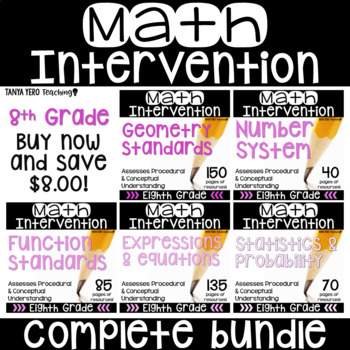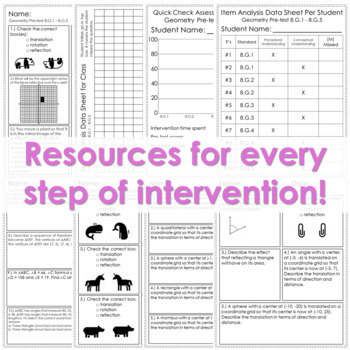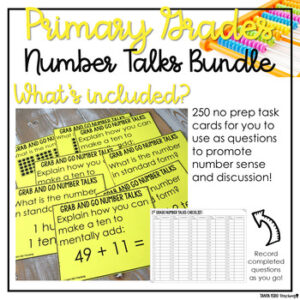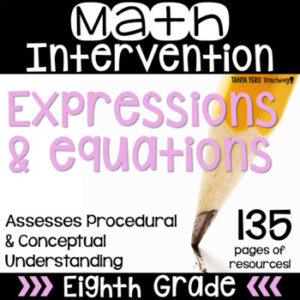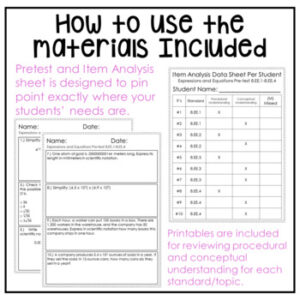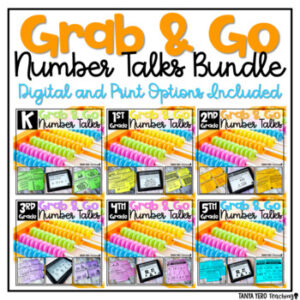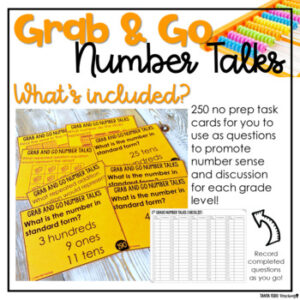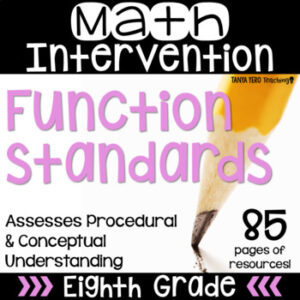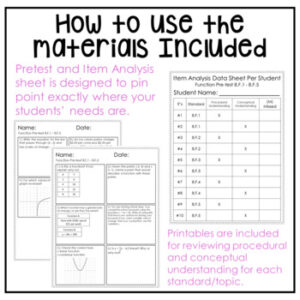Description
This resource pack is everything you need to assess and provide intervention for struggling 8th grade students in all five math domains.
How do these intervention packs work?
Starting with a pretest and item analysis of each question on the test, you will be able to pin-point exact needs of all students. From there printables and short assessments are provided for each standard that assess procedural and conceptual understanding. Data charts and documents are provided to help keep you organized and focused during all steps of the intervention process.
Take the guess work out of providing intervention and focus on what is really important… helping your students!
Looking for extensive graphing forms to help you stay organized during the RTI process? Check out our form Intervention Graphing Packs!
Standards & Topics Covered
Functions
➥ 8.F.1 – Understand that a function is a rule that assigns to each input exactly one output
➥ 8.F.2 – Compare properties of two functions each represented in a different way
➥ 8.F.3 – Interpret the equation y = mx + b as defining a linear function, whose graph is a straight line
➥ 8.F.4 – Construct a function to model a linear relationship between two quantities
➥ 8.F.5 – Describe qualitatively the functional relationship between two quantities by analyzing a graph
The Number System
➥ 8.NS.1 – Understand that every number has a decimal expansion
➥ 8.NS.2 – Use rational approximations of irrational numbers
Expressions and Equations
➥ 8.EE.1 – Develop and apply the properties of integer exponents to generate equivalent numerical expressions
➥ 8.EE.2 – Square and cube roots
➥ 8.EE.3 – Use numbers expressed in scientific notation to estimate very large or very small quantities and to express how many times as much one is than the other.
➥ 8.EE.4 – Perform multiplication and division with numbers expressed in scientific notation to solve real-world problems
➥ 8.EE.5 – Graph proportional relationships, interpreting the unit rate as the slope of the graph
➥ 8.EE.6 – Use similar triangles to explain why the slope m is the same between any two distinct points on a non-vertical line in the coordinate plane
➥ 8.EE.7 – Solve linear equations in one variable
➥ 8.EE.8 – Analyze and solve pairs of simultaneous linear equations
Geometry
➥ 8.G.1 – Verify experimentally the properties of rotations, reflections, and translations
➥ 8.G.2 – Using transformations to define congruency
➥ 8.G.3 – Describe the effect of dilations about the origin, translations, rotations about the origin in 90 degree increments, and reflections across the -axis and -axis on two-dimensional figures using coordinates.
➥ 8.G.4 – Use transformations to define similarity.
➥ 8.G.5 – Use informal arguments to analyze angle relationships.
➥ 8.G.6 – Explain the Pythagorean Theorem and its converse.
➥ 8.G.7 – Apply the Pythagorean Theorem and its converse to solve real-world and mathematical problems.
➥ 8.G.8 – Apply the Pythagorean Theorem to find the distance between two points in a coordinate system.
➥ 8.G.9 – Understand how the formulas for the volumes of cones, cylinders, and spheres are related and use the relationship to solve real-world and mathematical problems.
Statistics and Probability
➥ 8.SP.1 – Interpreting line plots
➥ 8.SP.2 – Understanding Bivariate quantitative data
➥ 8.SP.3 – Use the equation of a linear model to solve problems in the context of bivariate quantitative data, interpreting the slope and y-intercept.
➥ 8.SP.4 – Understand that patterns of association can also be seen in bivariate categorical data by displaying frequencies and relative frequencies in a two-way table.
~~~~~~~~~~~~~~~~~~~~~~~~~~~~~~~~~~~~~~~~~~~~~~~~~~~~
What is procedural understanding?
✓ Houses practice of procedural steps
✓ Requires facts, drills, algorithms, methods, etc.
✓ Based on memorizing steps
✓ Students are learning how to do something
***************************************************************************
What is conceptual understanding?
✓ Understanding key concepts and apply prior knowledge to the new concepts
✓ Understanding why something is done
✓ Making connections & relationships


